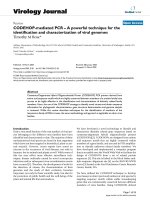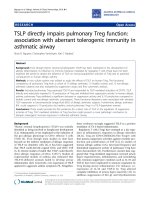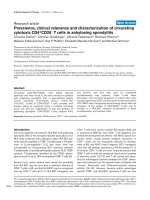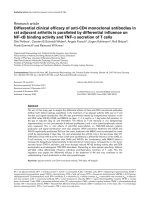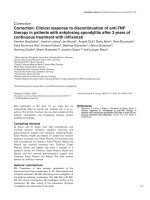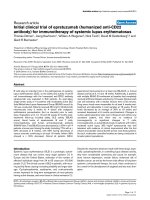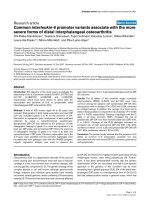Báo cáo y học: " Pro/con clinical debate: Pulmonary artery catheters increase the morbidity and mortality of intensive care unit patients" potx
Bạn đang xem bản rút gọn của tài liệu. Xem và tải ngay bản đầy đủ của tài liệu tại đây (38.92 KB, 3 trang )
101
Available online />A 35-year-old woman is in the intensive care unit (ICU) with
abdominal sepsis secondary to a perforated bowel.
Complications include acute respiratory distress syndrome and
hypotension, requiring mechanical ventilation and inotropes,
respectively. The only worrying laboratory values are a doubling
of the patient’s serum creatinine level (despite good urine
output) and a slightly elevated lactate level. You are
comfortable that surgical interventions are adequate and that
antibiotic selections are appropriate. However, despite your
best supportive care, the patient is not improving. You think a
pulmonary artery catheter (PAC) could assist you further but
you are worried that it may be harmful to the patient.
Commentary
Pro/con clinical debate: Pulmonary artery catheters increase the
morbidity and mortality of intensive care unit patients
Stephen E Lapinsky
1
and Guy A Richards
2
1
Associate Director, Intensive Care Unit, Mount Sinai Hospital and Interdisciplinary Division of Critical Care, University of Toronto, Canada
2
Director of Intensive Care, Johannesburg Hospital and Associate Professor, Department of Medicine, University of the Witwatersrand, Johannesburg,
South Africa
Correspondence: Critical Care Forum Editorial Office,
Published online: 24 December 2002 Critical Care 2002, 7:101-103 (DOI 10.1186/cc1872)
This article is online at />© 2003 BioMed Central Ltd (Print ISSN 1364-8535; Online ISSN 1466-609X)
Abstract
One of the highlights of the intensive care unit when I was a resident was the opportunity to place a
pulmonary artery catheter and then spend the rest of the day calculating parameters such as oxygen
delivery, oxygen consumption, intrapulmonary shunt fraction, and so on. I have noticed in the past few
years that the use of these devices in our unit is much less frequent. In our case I am not absolutely
certain of the reason for this. Perhaps with time our clinical sense has improved to the point that we do
not need the data available, perhaps other tests have replaced the pulmonary artery catheter’s role or
perhaps we are worried about the possible morbidity/mortality associated with its use. In the present
article, we revisit this important debate.
Keywords hemodynamics, pulmonary artery catheterization, pulmonary wedge pressure, Swan-Ganz
catheterization
The scenario
Pro: Yes, PACs increase the morbidity and mortality of ICU patients
Stephen E Lapinsky
Although PACs are widely used in critical care, the precise
role for this invasive monitoring intervention remains unclear.
One approach to this discussion would be a review of clinical
studies demonstrating a lack of efficacy of PACs in improving
outcome [1,2] or of studies suggesting a potential harmful
effect [3,4]. However, this argument does not seem to have
been effective in changing practice. The present discussion
will therefore take a logical approach to evaluating the
benefits of invasive hemodynamic monitoring in this clinical
scenario. Several pertinent questions should be considered.
What hemodynamic information do I need in this
patient?
This patient has septic shock with acute renal failure. The
clinical evaluation (jugular venous pressure, peripheral
perfusion) can be very informative and there is usually little
risk associated with careful additional volume administration.
A trial of the hemodynamic effects of progressive fluid
boluses [5] may be more useful than measurement of filling
pressures. The evaluation and correction of volume status
would be more important if the patients had imminently
ICU = intensive care unit; PAC = pulmonary artery catheter.
102
Critical Care 2003 Vol 7 Lapinsky and Richards
reversible prerenal failure. From the clinical scenario, it seems
probable that established acute tubular necrosis has
occurred, and urine electrolytes would be the investigation of
choice to assess this further. Knowledge of this patient’s
cardiac output is unlikely to be of value; any value from below
the normal to one moderately increased would not be
unexpected. Although the absolute values recorded may not
be immediately helpful, the trend and response to
vasopressors can be useful.
Can the PAC provide this information reliably?
Various factors influence the ability to derive accurate
hemodynamic information, and these should always be
considered. Intrinsically, the design of the PAC is
unfortunately not ideal for the reliable measurement of
pressures. An optimal system would use a short, large-bore
catheter with stiff tubing [6]. A number of patient factors may
make PAC measurements difficult or inaccurate [7]. A
common problem is the spontaneously breathing, tachypneic
patient. Pressure measurements and cardiac output
estimations rely on timing with the respiratory cycle. The large
intrathoracic pressure swings occurring in the patient with
respiratory distress can make accurate pressure
measurements impossible.
Another patient factor to consider is valvular heart disease.
Tricuspid regurgitation makes thermodilution cardiac output
difficult to interpret, and mitral regurgitation affects the nature
of the wedge pressure waveform. Concomitant interventions,
such as mechanical ventilation and positive end-expiratory
pressure, can influence pressure measurements in an
unpredictable way [8]. Inotropic agents can change
ventricular compliance and afterload, altering filling pressures
independent of volume changes [7].
Will this information change my management?
No matter how much information the PAC provides, it is
difficult to imagine that this invasive intervention can
positively affect outcome if it does not result in changes to
management. A useful exercise is to consider the various
management options available (e.g. fluid administration,
diuresis, vasopressors) and whether any specific
hemodynamic finding would, in fact, change treatment.
Summary
Invasive hemodynamic monitoring may have a role in the
management of a select group of ICU patients, if done by
properly trained physicians [9]. The potential risks are
significant, however, and in many situations PACs contribute
only to unnecessary morbidity and mortality [10].
Con: No, PACs do not increase morbidity and mortality of ICU patients
Guy A Richards
It should be remembered that hemodynamic monitoring is not
itself diagnostic of an underlying disease process unless the
patient is merely hypovolemic. The following discussion does
not therefore consider what further might be wrong with this
patient, but this obviously warrants further attention. It is,
however, necessary to support the patient until the primary
disease responds and invasive monitoring would be useful to
guide the use of vasoactive agents and fluid replacement.
Clinical parameters alone are relatively inaccurate with regard
to hemodynamic status in critically ill patients [11].
Parameters that are of particular value are cardiac output,
pulmonary artery occlusion pressure, mixed venous oxygen
saturation, right ventricular end diastolic volume, and
systemic vascular resistance. Whereas some parameters
may be obtainable with less invasive techniques, such as
Doppler esophageal monitoring, only the PAC can easily and
continuously or repetitively monitor them all. Despite these
benefits, no agreement has been reached with regard to its
potential to cause harm [12]. There have even been calls for
a moratorium on its use until the issue is settled [13,14].
Most recent studies, although not showing benefit, have not
shown an increase in mortality or morbidity [15,16]; although
some have found an increase in length of stay and costs.
Those studies that do suggest an increased mortality have
serious methodologic flaws such as small numbers of
heterogeneous patient populations, inappropriate use of the
PAC, insufficient evaluation of intensivist expertise and
nonprotocol-driven therapeutic strategies in response to PAC
data [17,18].
The most important shortcoming of the PAC appears to be
that the derived data is incorrectly measured, interpreted and
utilized [19]. In a recent study by Squara and colleagues, at
least 35% of doctors attending three critical care congresses
suggested at least one potentially harmful intervention when
assessing clinical data in a case study provided. Subsequent
to insertion of a PAC, the range of treatments and the
number of harmful interventions were reduced and there was
improved agreement between participants and designated
experts as to correct management [20]. Nevertheless, the
harmful interventions remained greater than 15% even
without the participants themselves having to measure and
record the PAC data. Ten percent of physicians still
suggested harmful therapeutic strategies even after three
PAC recordings were given, effectively increasing PAC-
associated mortality by 30%. This study concurs that the
PAC is more accurate than clinical assessment of
hemodynamic status and that, when correctly utilized,
diagnosis and management is improved. However, the
persistent misutilization of data by a relatively small
percentage of participants, and by extension a small
percentage of study populations, will result in the
103
Available online />Pro’s response
Stephen E Lapinsky
As Guy Richards points out, both clinical assessment and
PAC measurement are associated with errors in evaluation
and management. Clinical assessment is sometimes
inaccurate in the evaluation of hemodynamic status but,
similarly, PAC data is often incorrectly interpreted and
utilized. The current standard of practice is to insert a PAC
in cases of hemodynamic uncertainty. As there is no data
supporting a beneficial effect of the PAC in patients with
hemodynamic compromise, the default state should be to rely
on the clinical assessment. The PAC should be reserved for
the minority of cases where, despite attempts to optimize
therapy, further hemodynamic information is required and
where these data can be interpreted and utilized correctly.
Con’s response
Guy A Richards
Stephen Lapinsky has not provided any evidence that the
PAC would increase mortality. He states only that
hemodynamic data would be unnecessary and that
measurements may be unreliable. In terms of the former,
clinical data must have been insufficient as “despite best
supportive care” the patient did not improve. In terms of the
latter, the circumstances in which the PAC is unreliable do
not apply to this patient; the fact that she was ventilated and
was on inotropes without improvement mandates
hemodynamic monitoring to exclude adverse effects of these
interventions. It is true that the PAC is of value in certain
selected patients. The present scenario describes just such a
patient.
misconception that the PAC has no effect on or actually
increases mortality. Studies that examine homogeneous
populations with protocol-driven responses are the only ones
likely to show benefit.
In conclusion, in the present scenario a PAC inserted by an
intensivist trained in its use and utilizing protocol-directed
responses would not increase mortality and morbidity, and
probably would improve outcome.
1. Guyatt G: A randomized control trial of right-heart catheteriza-
tion in critically ill patients. Ontario Intensive Care Study
Group. J Intensive Care Med 1991, 6:91-95.
2. Gattinoni L, Brazzi L, Pelosi P, Latini R, Tognono G, Pesenti A,
Fumagalli R: A trial of goal-oriented hemodynamic therapy in
critically ill patients. SvO
2
Collaborative Group. N Engl J Med
1995, 333:1025-1032.
3. Hayes MA, Timmins AC, Yau EH, Palazzo M, Hinds CJ, Watson D:
Elevation of systemic oxygen delivery in the treatment of criti-
cally ill patients. N Engl J Med 1994, 330:1717-1722.
4. Connors AF, Speroff T, Dawson NV, Thomas C, Harrell FE,
Wagner D, Desbiens N, Goldman L, Wu AW, Califf RM, Fulker-
son WJ, Vidaillet H, Broste S, Bellamy P, Lynn J, Knaus WA: The
effectiveness of right heart catheterization in the initial care of
critically ill patients. SUPPORT Investigators. JAMA 1996,
276:889-897.
5. Webb AR: Recognizing hypovolaemia. Minerva Anestesiol
2001, 67:185-189.
6. Gardner RM: Direct blood pressure measurements — dynamic
response requirements. Anesthesiology 1981, 54:227-236.
7. Raper R, Sibbald WJ: Misled by the wedge? The Swan–Ganz
catheter and left ventricular preload. Chest 1986, 89:427-434.
8. Rajacich N, Burchard KW, Hasan FM, Singh AK: Central venous
pressure and pulmonary capillary wedge pressure as esti-
mates of left atrial pressure: effects of positive end-expiratory
pressure and catheter tip malposition. Crit Care Med 1989,
17:7-11.
9. Iberti TJ, Fischer EP, Leibowitz AB, Panacek EA, Silverstein JH,
Albertson TE: A multicenter study of physicians’ knowledge of
the pulmonary artery catheter. Pulmonary Artery Catheter
Study Group. JAMA 1990, 264:2928-2932.
10. Dalen JE, Bone RC: Is it time to pull the pulmonary artery
catheter? JAMA 1996, 276:916-918.
11. Abou-Khalil B, Scalea TM, Trooskin SZ, Hitchcock R: Hemody-
namic responses to shock in young trauma patients: need for
invasive monitoring. Crit Care Med 1994, 22:633-639.
12. Trotter SJ, Taylor RW: Physicians attitudes toward and knowl-
edge of the pulmonary artery catheter. Society of Critical Care
Medicine membership survey. New Horiz 1997, 5:201-206.
13. Bernard GR, Sopko G, Cerra F, Demling R, Edmunds H, Kaplan
S, Kessler L, Masur H, Parsons P, Shure D, Webb C, Weidemann
H, Weinmann G, Williams D: Pulmonary artery catheterization
and clinical outcomes. National Heart, Lung and Blood Insti-
tute and Food and Drug Administration workshop report. Con-
sensus Statement. JAMA 2000, 283:2568-2570.
14. Pulmonary Artery Catheter Consensus Conference: Consensus
statement. Crit Care Med 1997, 25:910-925.
15. Rhodes A, Cusack RJ, Newman PJ: A randomized controlled
trial of pulmonary artery catheter in critically ill patients. Inten-
sive Care Med 2002, 28:256-264.
16. Williams G, Grounds M, Rhodes A: Pulmonary artery catheter.
Curr Opin Crit Care 2002, 8:251-256.
17. Ivanov R, Allen J, Sandham J, Calvin JE: Pulmonary artery
catheterization: a narrative and systematic critique of random-
ized trials and recommendations for the future. New Horiz
1997, 5:268-276.
18. Sibbald N, Keenan S: Show me the evidence: a critical
appraisal of the Pulmonary Artery Consensus Conference and
other musings on how critical care practitioners need to
improve the way to conduct business. Crit Care Med 1997,
25:2060-2063.
19. Gnaegi A, Feihl F, Perret C: Intensive care physicians insuffi-
cient knowledge of right heart catheterization at the bedside:
time to act? Crit Care Med 1997, 25:213-220.
20. Squara P, Bennet D, Perret C: Pulmonary artery catheter: does
the problem lie with the users. Chest 2002, 121:2009-2015.
References

